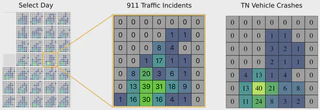Explorative Visualization for Traffic Safety using Adaptive Study Areas
Jan 14, 2021· ,,,,,·
0 min read
,,,,,·
0 min read
Andreas Berres
Haowen Xu
Sarah Tennille
Joseph Severino
Srinath Ravulaparthy
Jibonananda Sanyal
 The calendar view shows the incident distribution of a selected dataset over time. Each day’s incidents are displayed as a tile on the calendar. When the tile for a day is selected in the calendar view, a detailed version of the tile is displayed next to the calendar. The user can then choose to compare this detailed view with another dataset that is available for the same day. In this example, we have selected August 21, 2019 (left), and we have chosen to compare crashes from the Hamilton County 911 dataset (middle) with corresponding crashes from the Tennessee Vehicle Crashes dataset (right).
The calendar view shows the incident distribution of a selected dataset over time. Each day’s incidents are displayed as a tile on the calendar. When the tile for a day is selected in the calendar view, a detailed version of the tile is displayed next to the calendar. The user can then choose to compare this detailed view with another dataset that is available for the same day. In this example, we have selected August 21, 2019 (left), and we have chosen to compare crashes from the Hamilton County 911 dataset (middle) with corresponding crashes from the Tennessee Vehicle Crashes dataset (right).Abstract
The pressing need to improve traffic safety has become a societal concern in many cities around the world. Many traffic accidents are not occurring as stand-alone events but as consequences of other road incidents and hazards. To capture the traffic safety indications from a holistic aspect, this paper presents a suite of visualization techniques to explore large traffic safety datasets collected from different sources using adaptive study areas which include the whole region (Hamilton County, Ohio, U.S.) as well as smaller sub-areas. In the present study, these data source include (1) Hamilton County’s 911 emergency response data, which includes traffic incidents as well as other types of incidents throughout the county, and (2) Tennessee crash data, which contains only vehicle crashes with more detail on the circumstances of each crash. Both abstract and spatial visualization techniques are used to derive a better understanding of traffic safety patterns for different traffic participants in various urban environments. In addition to the entire region of Hamilton County, safety is examined on the highways, in the downtown area, and in a shopping district east of the city center. It is possible to characterize incidents in the different areas, gain a better understanding of common incident patterns, and identify outliers in the data. Finally, a textured tile calendar is presented to compare spatiotemporal patterns.
Type
Publication
In Transportation Research Record: Journal of the Transportation Research Board